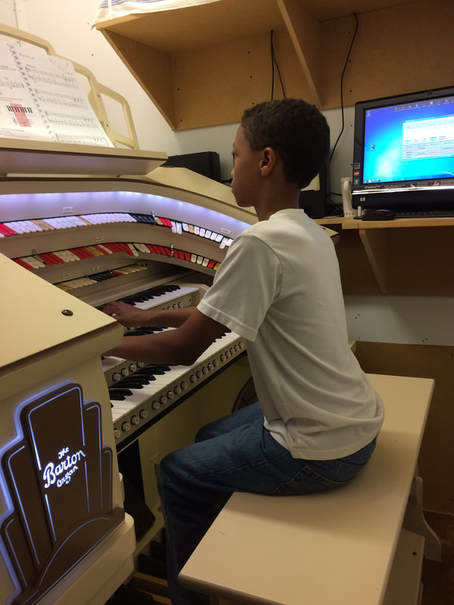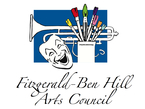Big Bart History
The Barton organ was originally installed in the Orpheum Theater in Galesburg, Illinois in the summer of 1926. It was played for silent film and as part of traveling shows on the road between Chicago and St. Louis, Missouri. In the mid-1930’s along with so many theater organs around the world, it went silent as movies started having their own sound tracks. The Barton was played occasionally, until the closing of the venue after WWII. In 1961, John Near was 14 years old and in love with the sound of this instrument. The theater had been closed and was part of a city block that was in peril of demolition. A bank stood on one side and the hotel on the other of the theater. He could not stand to lose this gem, so before his time, he started campaigning to become the owner of the instrument. He wrote to the executor of the estate holding the properties. A letter from their lawyer responded saying it was a nice thought, but not to hold his breath. A few months later, another reply was received from the lawyer stating he would be permitted to remove the instrument, he had 120 days, could not damage anything in the building during the extraction and had to be bonded to do so. They would sell him the instrument for $1,000.00. With the permission and support of his parents, John and his brother, Bruce began the project. They worked every available hour to remove the pipes, the chests, cabling, wind lines and various other parts of the instruments. The instrument was stored in their new home’s basement and extra barn on their family farm. John and Bruce spent the next 3 years cleaning and rebuilding the instrument in the attic of this French provincial style home. The console was recessed into a wall in the parlor, and a tone opening cut into the ceiling to allow the instrument to speak down into the house. The first sounds of the tibia flute were heard 3 years after they began this process. John wrote and visited whoever had information about how to install this 15 rank instrument and make it work. Renown concert organist, Virgil Fox, played the finished product in the home on one of his trips between the bigger cities. This instrument became well known in the theatre organ world because of the boy-wonder who assembled it in his home to save it.
Fast forward to 2008 and move 1000 miles southeast to Fitzgerald, Georgia. It had been a dream of many people in the community to once again have a functioning theater organ in their historic venue. After hiring Jonathan Durkovic to manage and re-open the Grand Theatre and restore it to the activity of the past and expand its programming use to include many various aspects, it was decided to study what would be the path to take to make this dream a reality. Organ company representatives were brought in to study the space and make suggestions and proposals about how large an instrument the space could house and where to locate all of the various parts. It was determined a new instrument would cost approximately $250,000.00 to build and install. There would be additional costs required to fortify the stage and construct chambers to house all of the various components. It was decided to wait until either someone donated an instrument or something else could be done. He was instructed to keep a lookout for such an offer.
Fast forward to 2008 and move 1000 miles southeast to Fitzgerald, Georgia. It had been a dream of many people in the community to once again have a functioning theater organ in their historic venue. After hiring Jonathan Durkovic to manage and re-open the Grand Theatre and restore it to the activity of the past and expand its programming use to include many various aspects, it was decided to study what would be the path to take to make this dream a reality. Organ company representatives were brought in to study the space and make suggestions and proposals about how large an instrument the space could house and where to locate all of the various parts. It was determined a new instrument would cost approximately $250,000.00 to build and install. There would be additional costs required to fortify the stage and construct chambers to house all of the various components. It was decided to wait until either someone donated an instrument or something else could be done. He was instructed to keep a lookout for such an offer.
|
Labor Day weekend 2009, while selling tickets to “Mummy 3”, the theatre manager read an ad in The American Theatre Organ Society journal offering just an instrument for free to a good home. He tried making the contact with permission of local leadership. The following week, a friendship had been made between now Dr. John Near and leadership in Fitzgerald. A visit to see the instrument was setup, with representation from the City of Fitzgerald, the County Commission and Economic Development. It was determined the instrument would indeed be donated to Fitzgerald with the agreement it would be renovated, installed and played regularly. An excited meeting helped seal the friendship and the group set about seeking support to do the project. Finding adequate support, it was decided to take the offer.
Saturday morning, December 26th , 2009, a team of 8 from Fitzgerald left in a van together to meet staff of A E Schlueter Pipe Organ Company in Galesburg, Illinois. The group met the next morning at the farm in a blizzard to begin the process of removing the organ from the house. Pipes were passed from the chests through the house and carefully placed in trays for shipping. A donated freight truck could not make it up the lane to the house, so the pipe trays were loaded into a moving van, then backed down the lane to be transferred into the freight truck. This process was repeated for 2-1/2 days until the entire instrument was packed into the truck. The console was removed from the parlor and left the house exactly 45 years to the day from the time it first arrived. Some of the pipes were so large, the only way to get them out of the house was to pass them out through a 2 nd floor window. The blower and electrical systems were dismantled and all parts of the organ were safely stored in the freight truck for shipping to Lithonia, Georgia to Schlueter’s factory. |
During the course of 2010, every part of the organ was tested, cleaned, restored and in some cases due to age or damage, replaced. Voicing of the pipework was kept original as it had been when moved the 1st time into the home. Meanwhile, funds were being generated through corporate and individual donations. Matching grants were written and received from The Fox Theatre Foundation, The American Theatre Organ Society, and The Economic Development Group. Half of the necessary funds were raised very quickly. It was decided to fund the restoration and installation through the Economic Development Fund and use the instrument as a tool for tourism. Various individuals and companies in the community donated time, labor and materials to help prepare the stage area and build new chambers to house the organ. A contest was held to name it. The Grand Barton March, a piece composed specifically to honor this instrument in this venue, has only been played here on this instrument.
Monday, January 17th, 2011 was Martin Luther King day and the day that the first parts of the organ began to arrive in Fitzgerald. The blower had already arrived and been serviced by Wynn Electric to verify its capacity and safe operation. Volunteers from the community, both young and old help to unload the truck with the various organ parts, which were placed carefully all over the theatre stage, on the floor in front of the stage and prepared for installation. Movies continued to run on the big screen even with the organ parts scattered, because once they were installed they would never be seen again. It was important for residents to see the immensity of the parts in this instrument. The current organ is 18 ranks of pipes with another 18 various percussions, plus toy counters and literally bells and whistles. The console is solid state with Uniflex as the operating system. LED lights glow in the console and imitate the marquee of the theatre, or can be turned white for a concert or dimmed for accompanying silent film.
On Saturday, March 25 th , 2011, R Jelanie Eddington, world reknown theatre organist, played the inaugural concert on what was then named, “Big Bart“. A party with a cake shaped like the Grand Theatre and balloons was held on stage following the concert. The music played included show tunes, a tango, a James Bond music medley and many other treats.
The organ has been used for silent film and organ concerts as well as accompanying Wiregrass Graduation ceremonies, Fitzgerald High School Baccalaureate ceremonies, Summer Arts Camps, organ lessons, and in July 2012, a concert presented by the American Theater Organ Society including members and visitors from 20 different countries. It is frequently visited by theatre organ fans and played by the house organist. Local piano students are also encouraged to come play.
The console is open to those who wish to play it. To schedule a tour and have the opportunity to hear and play Big Bart, please contact the theatre office.
Monday, January 17th, 2011 was Martin Luther King day and the day that the first parts of the organ began to arrive in Fitzgerald. The blower had already arrived and been serviced by Wynn Electric to verify its capacity and safe operation. Volunteers from the community, both young and old help to unload the truck with the various organ parts, which were placed carefully all over the theatre stage, on the floor in front of the stage and prepared for installation. Movies continued to run on the big screen even with the organ parts scattered, because once they were installed they would never be seen again. It was important for residents to see the immensity of the parts in this instrument. The current organ is 18 ranks of pipes with another 18 various percussions, plus toy counters and literally bells and whistles. The console is solid state with Uniflex as the operating system. LED lights glow in the console and imitate the marquee of the theatre, or can be turned white for a concert or dimmed for accompanying silent film.
On Saturday, March 25 th , 2011, R Jelanie Eddington, world reknown theatre organist, played the inaugural concert on what was then named, “Big Bart“. A party with a cake shaped like the Grand Theatre and balloons was held on stage following the concert. The music played included show tunes, a tango, a James Bond music medley and many other treats.
The organ has been used for silent film and organ concerts as well as accompanying Wiregrass Graduation ceremonies, Fitzgerald High School Baccalaureate ceremonies, Summer Arts Camps, organ lessons, and in July 2012, a concert presented by the American Theater Organ Society including members and visitors from 20 different countries. It is frequently visited by theatre organ fans and played by the house organist. Local piano students are also encouraged to come play.
The console is open to those who wish to play it. To schedule a tour and have the opportunity to hear and play Big Bart, please contact the theatre office.
CONTACT THE DEPARTMENT OF TOURISM, ARTS & CULTURE
* Additional showtimes by reservation or special event. See the Grand Theatre Facebook page or the Calendar of Events for specific showtimes and schedule updates. Movies and live performances are subject to change without notice.

















